

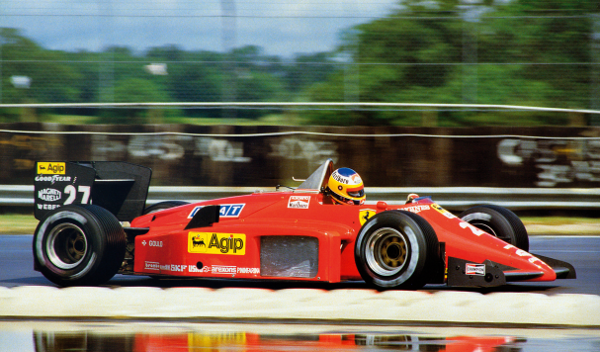
Michele Alboreto is just that:
The extraordinary story of a boy who, like so many others, followed the races behind the metal fences of the Monza racetrack, and in a few years he became the final Italian driver to claim victory in a Grand Prix behind the wheel of a Ferrari
Neither rich, nor daddy's boy, he did not belong to a generation of "kart drivers".
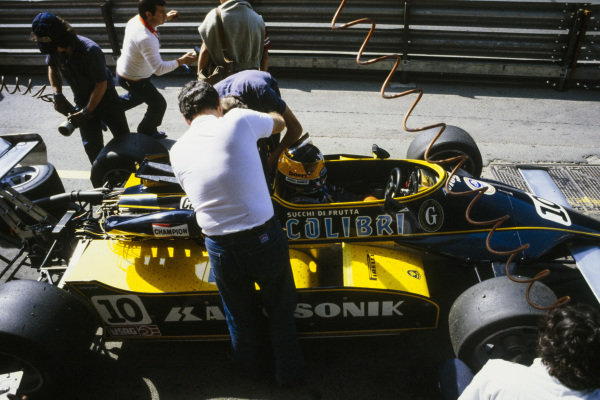 Alboreto with Minardi, Pau GP, Circuit de Pau (1981)
Alboreto with Minardi, Pau GP, Circuit de Pau (1981)
Born in Milan on December 23, 1956, he made his debut in world of racing in 1976 at the wheel of a “Formula Monza” of Scuderia Salvati. Hungry for victory, animated by a "young rage", he showcased himself as an authentic aggressive driver—much like his idol, the legendary Ronnie Peterson. It was from Peterson that he adopted the blue and yellow colors of his helmet.
Two years later, in "Formula Italia," his victory in Magione opened the doors of Formula 3, which was no small feat in the late seventies. Already a vice-champion in his first year, he claimed the top spot in 1980. During the same year, he was also recruited by Lancia for the endurance championship.
In 1981, in F2 with Minardi. he imposed himself at Misano against the official March and Spirit teams, achieving the only triumph in the history of the Minardi team. In addition to new victories with the Lancia LMP1, thanks to the 'mediation' of some friends, came the call from Ken Tyrrell.
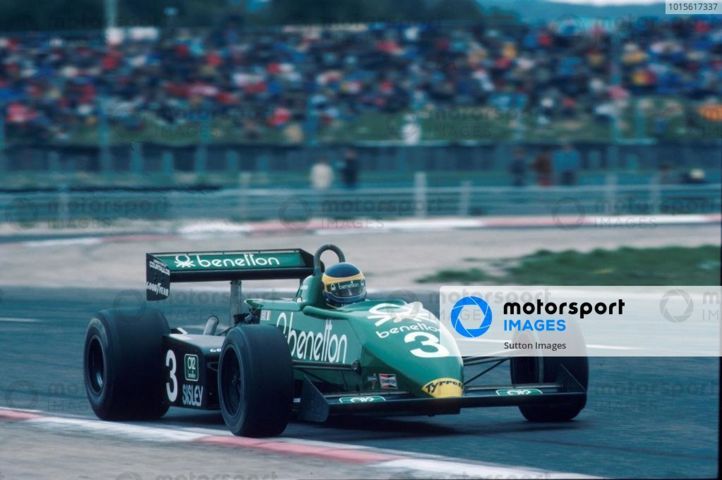 Michele Alboreto(I), Tyrrell 011, 8th place
French GP, Paul Ricard, France, 17 April 1983
Michele Alboreto(I), Tyrrell 011, 8th place
French GP, Paul Ricard, France, 17 April 1983
The great talent scout of the Formula 1 Circus offered him a seat for the San Marino GP. He exploited the opportunity well, and his apprenticeship in F1 continued for the rest of the championship and the following year. Still driving for the Tyrrell team, the breakthrough came with the incredible victory in Las Vegas in the last race of the season.
Enzo Ferrari put aside his proverbial xenophilia and began to keep an eye on him. In 1983, he gave another victory to Tyrrell and the glorious Ford Cosworth, marking the last victory in their history on the Detroit street circuit. By this time, he had become one of the best drivers in the world."
At the end of the season, a McLaren offer was on the table. However, when the call from Enzo Ferrari came in October of that year, Michele didn't hesitate: from 1984 onwards, he would be a Ferrari driver alongside Renè Arnoux.
An Italian driver had been absent from the Ferrari team for eleven years, dating back to the distant era of Arturo Merzario.
In that year, another important event took place in his life his marriage to Nadia, his lifelong love. Their relationship had blossomed during his youth on the outskirts of Milan (Rozzano), a place he never forgot,always staying close to his childhood friends
In 1984 the McLarens of Lauda and Prost were superior but Michele got his first historic victory at Zolder in red and then gives the "home" fans a nice second place in Monza. The wait is for the following year and with the new 156/85 Ferrari takes off at the start of the season.
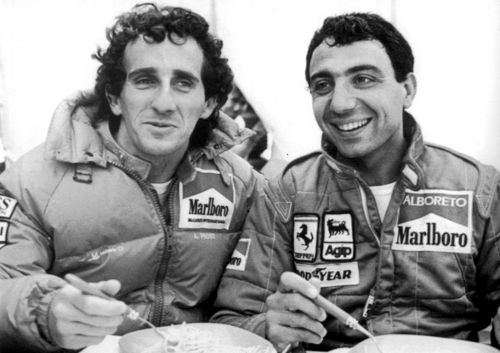 Michele and Alain Prost
Michele and Alain Prost
After excellent placements, Alboreto wins in Canada but his greatest triumph is at the Nurburgring, where he leaps to the top of the World Championship and his world ambitions are concrete. An incredible series of engine failures, however, will deliver the title to Prost and (again) to McLaren, leaving him the place of honor and a bitter taste in the mouth.
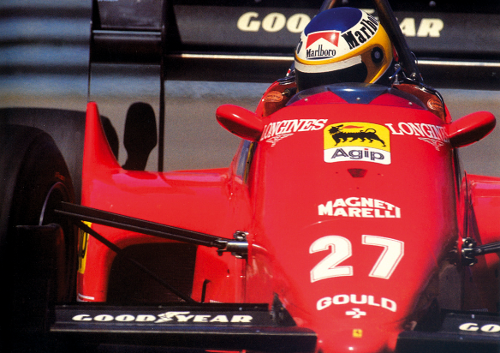 Alboreto with Ferrari 1985
Alboreto with Ferrari 1985
It's a missed opportunity; an Italian World Champion has been absent since the heroic era of another Milanese driver, Alberto Ascari. After a disappointing 1986 season, Ferrari embarked on a new technical journey with John Barnard at the helm. Meanwhile, Alboreto's new teammate, the Austrian driver Gerhard Berger, achieved victories in Japan and Australia during the 1987 season.
In 1988, McLaren's dominance was almost unbroken, except for a remarkable exception at Monza. Only a month had passed since Enzo Ferrari's passing, and the Ferrari team managed to achieve a remarkable double victory filled with emotion and significance on the Brianza circuit, which hosts the Italian Grand Prix.
Alboreto secured the second position on the podium, surrounded by a sea of red flags, as he bid farewell to the Ferrari team and the Cavallino Rampante (Ferrari's symbol). Shortly before his passing, Enzo Ferrari had called Alboreto to Maranello. With Nigel Mansell set to join the team the following year, the decision was still in the hands of the influential Ferrari Chief. Despite the possibility of contract renewal, Alboreto decided to move on.
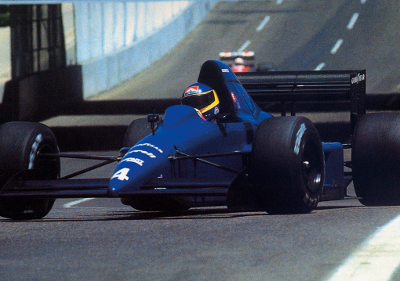 Alboreto with Tyrrell 018 - 1989
Alboreto with Tyrrell 018 - 1989
For the 1989 season, after the possibility of join Williams has faded, Alboreto returned to where his Formula One journey began: the blue Tyrrell 017. Despite limited resources and lacking major sponsors, he achieved an incredible third-place finish in Mexico, marking his final podium appearance in the sport.
During a mid-season contractual issues, he moved on to the modest Larrousse team, followed by stints at Footwork (achieving some respectable results in 1992) and the Scuderia Italia (a challenging year). In 1994, he reunited with his old team Minardi. Tragically, amidst the events of Imola, he comprehended that Ayrton Senna's fatal accident would profoundly transform the sport's atmosphere.
Alboreto secured a splendid sixth place in Monaco, his final race that garnered a point, culminating his illustrious and extensive Formula One career spanning 215 Grands Prix and 5 victories.
The decision to continue his career proved to be wise for Alboreto. In 1997, his collaboration with the Joest team, driving a Porsche, led to a victory at the 24 Hours of Le Mans. Two years later, as the team transitioned into the Audi team, Alboreto embarked on a quest for a repeat victory in the iconic French race.
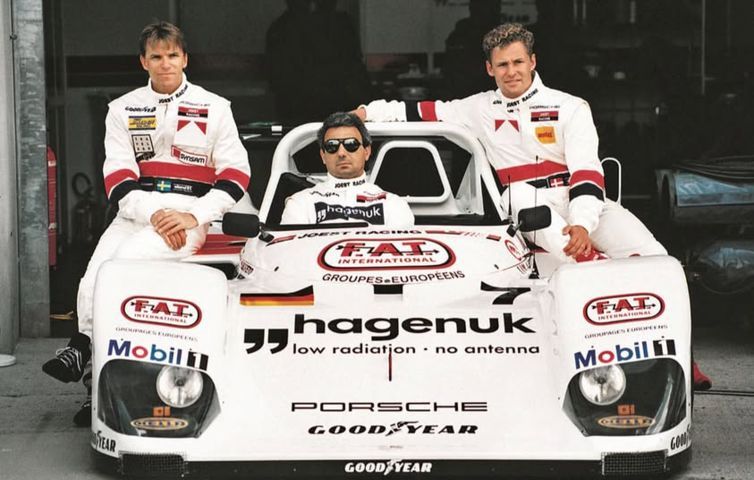 winnin car and drivers squad-lemans1997
winnin car and drivers squad-lemans1997
The year 2001 began with promising prospects. Alongside teammates Capello and Aiello, Alboreto triumphed in the 12 Hours of Sebring, driving the Audi R8.
On April 25th, a Wednesday, Alboreto's tragic accident occurred. While testing a car's tire at Audi Sport on the Lausitzring circuit, he collapsed while traveling at a speed of 300 km/h, causing the car to lift off and roll over. This incident drew parallels to the fate of the legendary Alberto Ascari. Just like Ascari, Michele Alboreto met his end away from the glamorous spotlight of racing, during a routine test session.
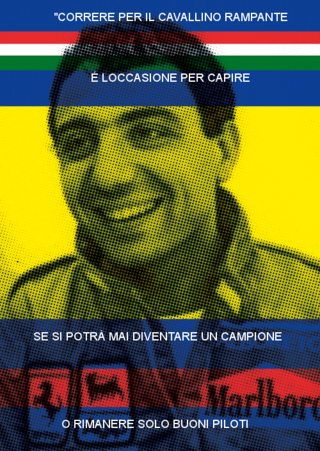
At the age of only 44, Alboreto's life came to a close, leaving behind a storied past, a significant present in racing, and a future that undoubtedly would have extended his role as a moral guide, not only within the world of motorsport.
Today, Michele Alboreto's lessons are still alive and strong. He was born to race, and wasn’t in this sport by accident—he knew everything about it. Maybe that’s why, with his smile, it feels like he’s still here with us.
A champion, a friend. Thank you, Michele.